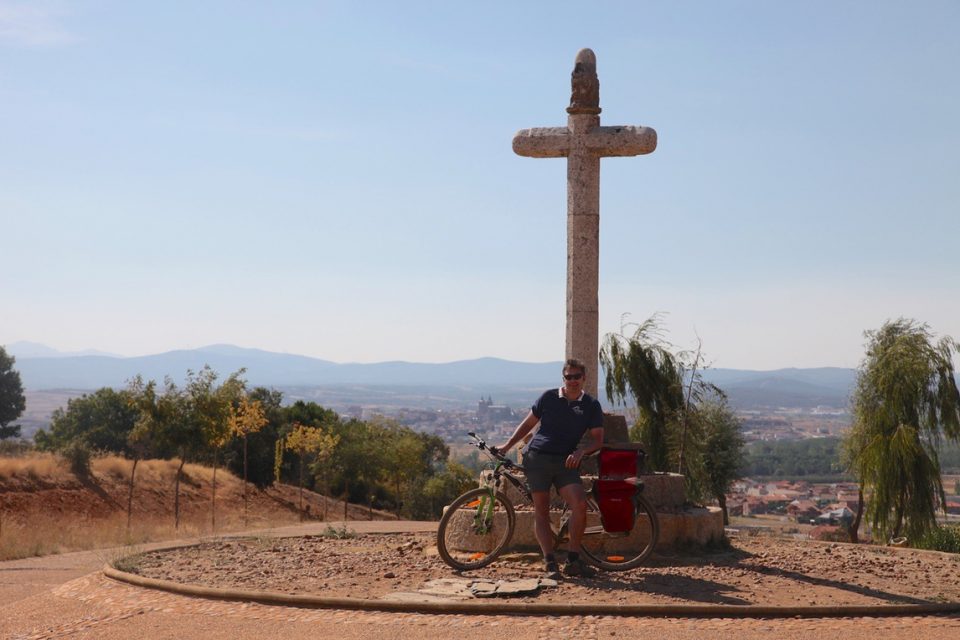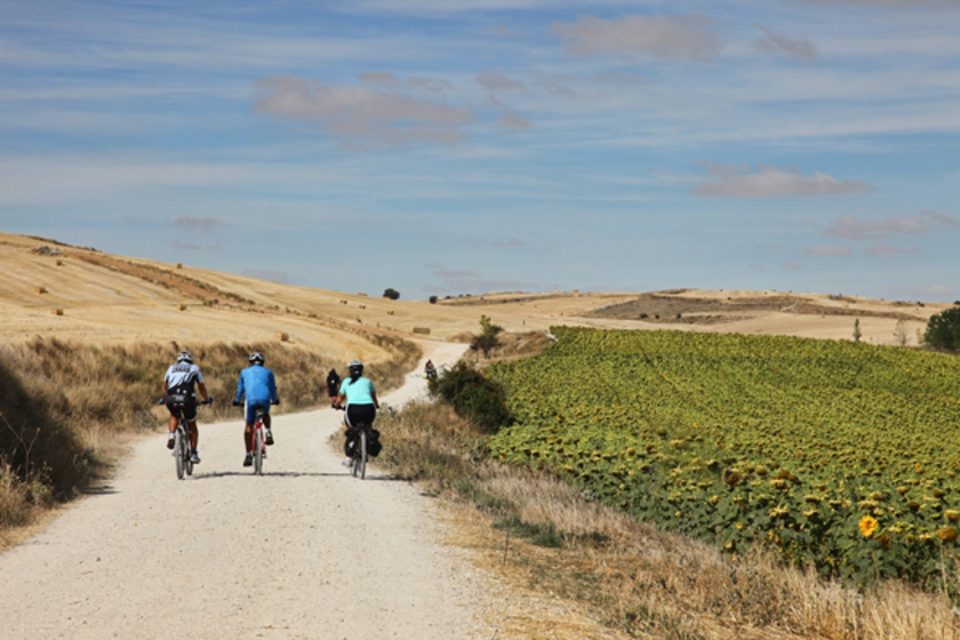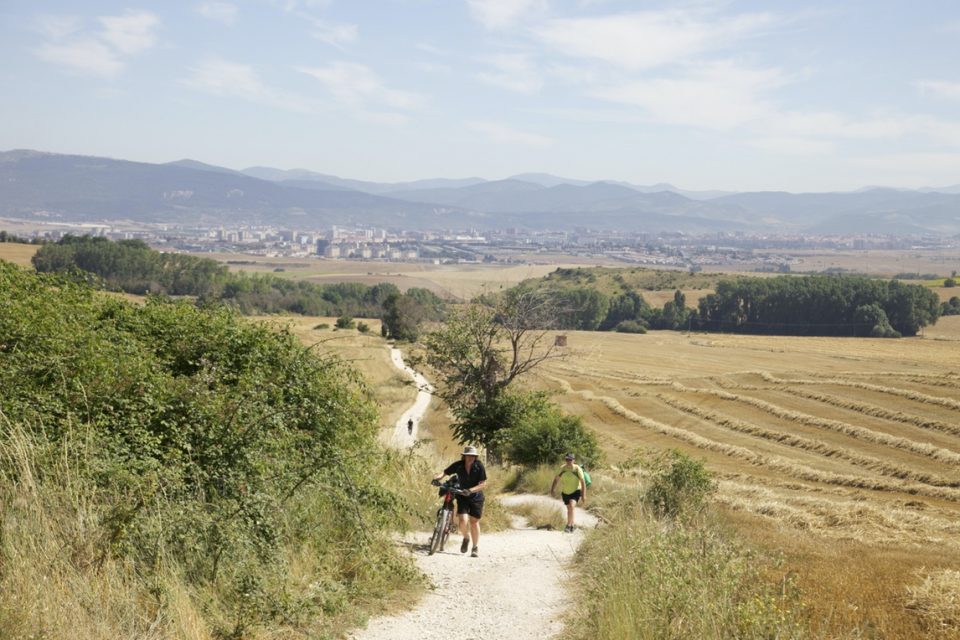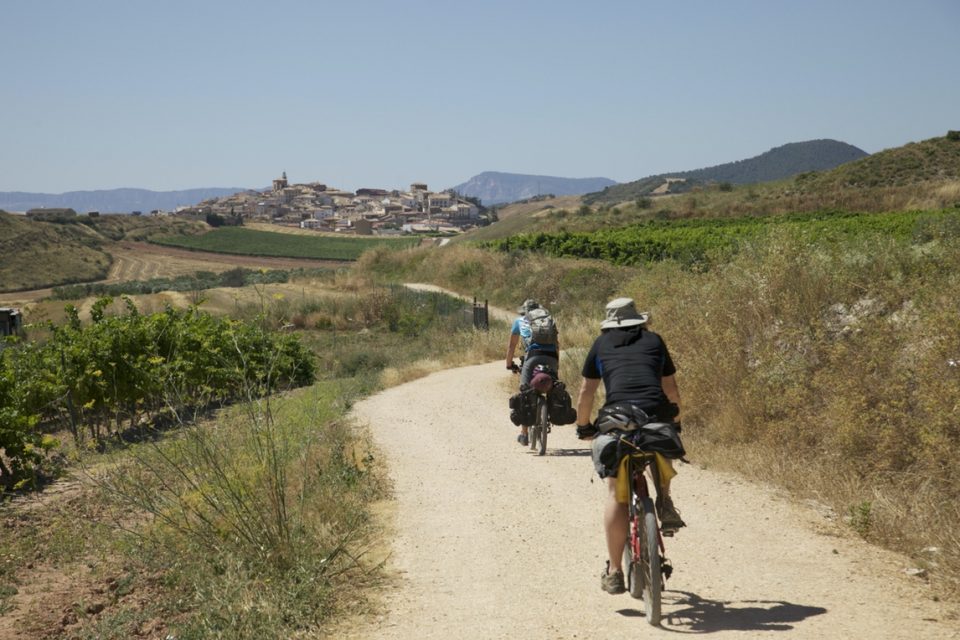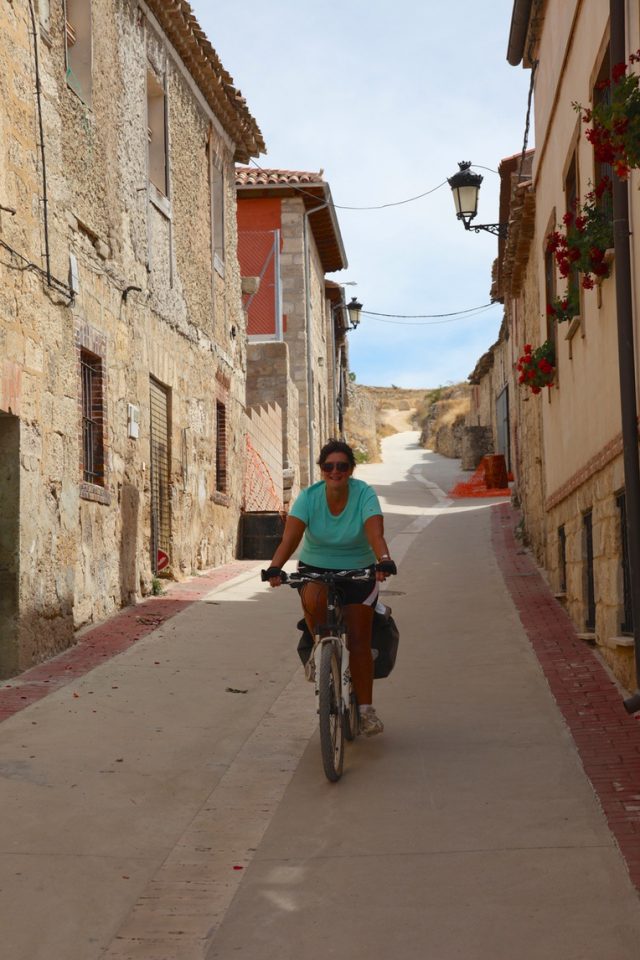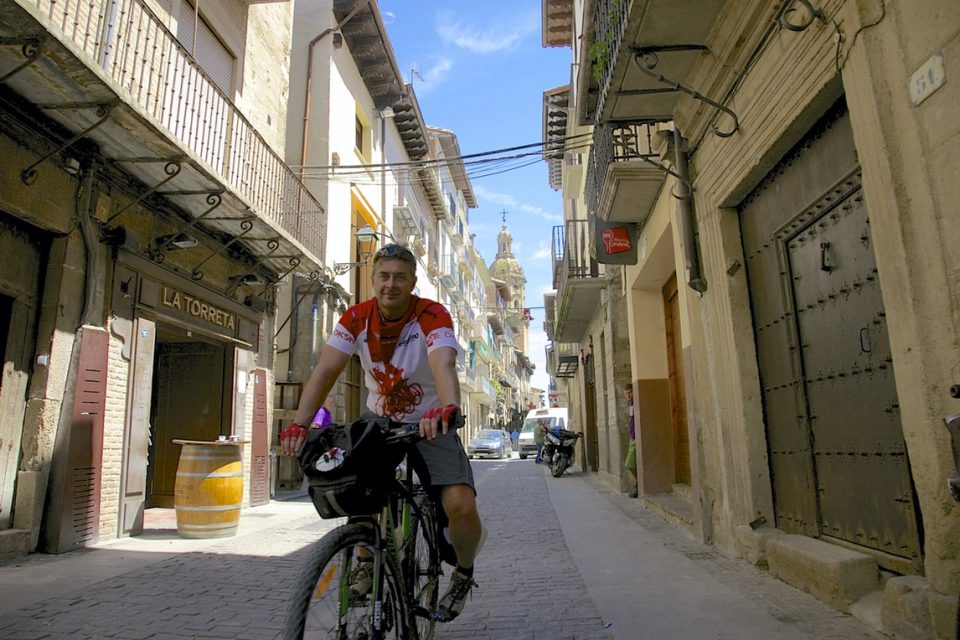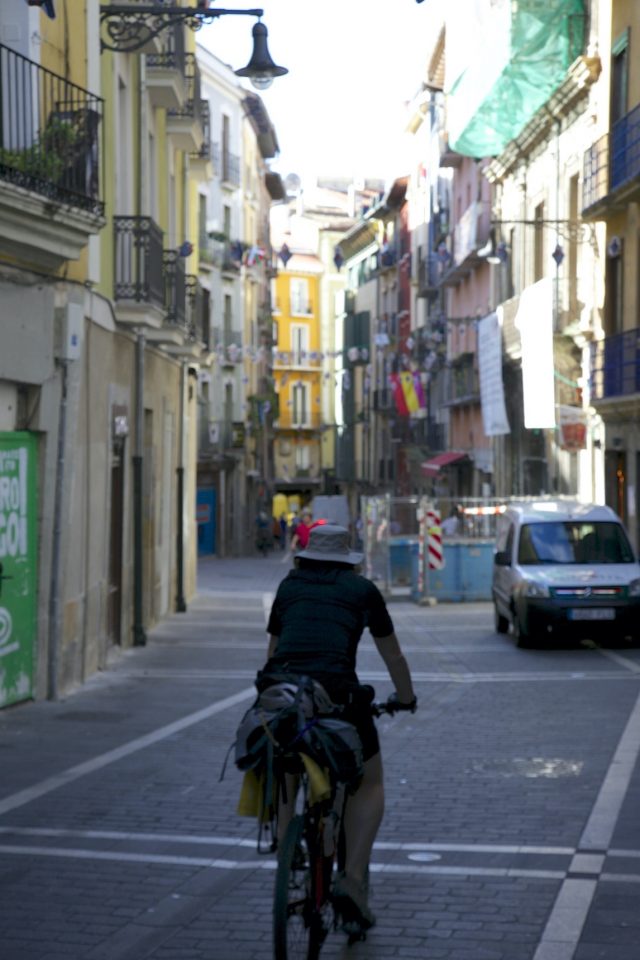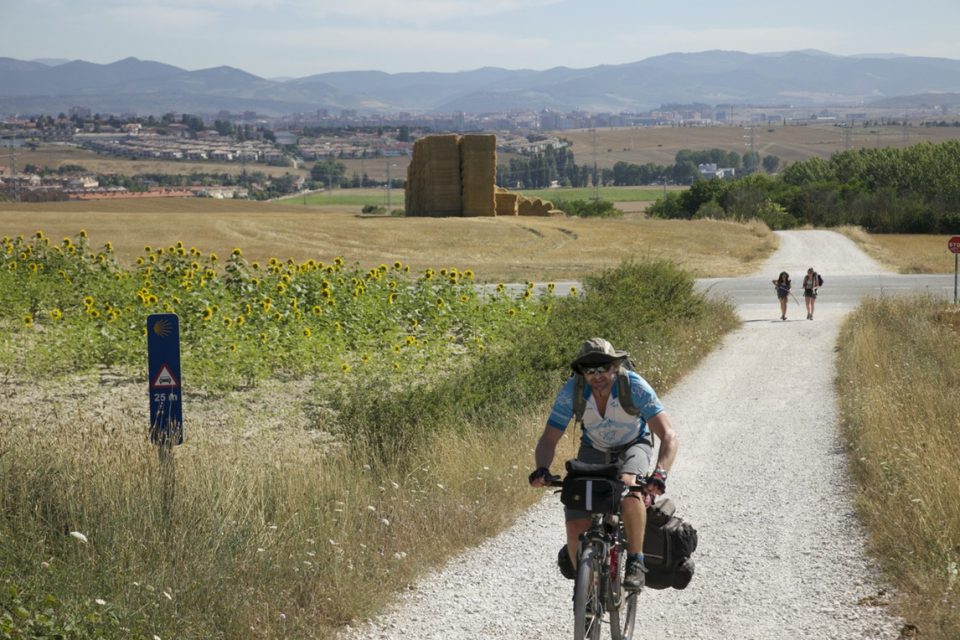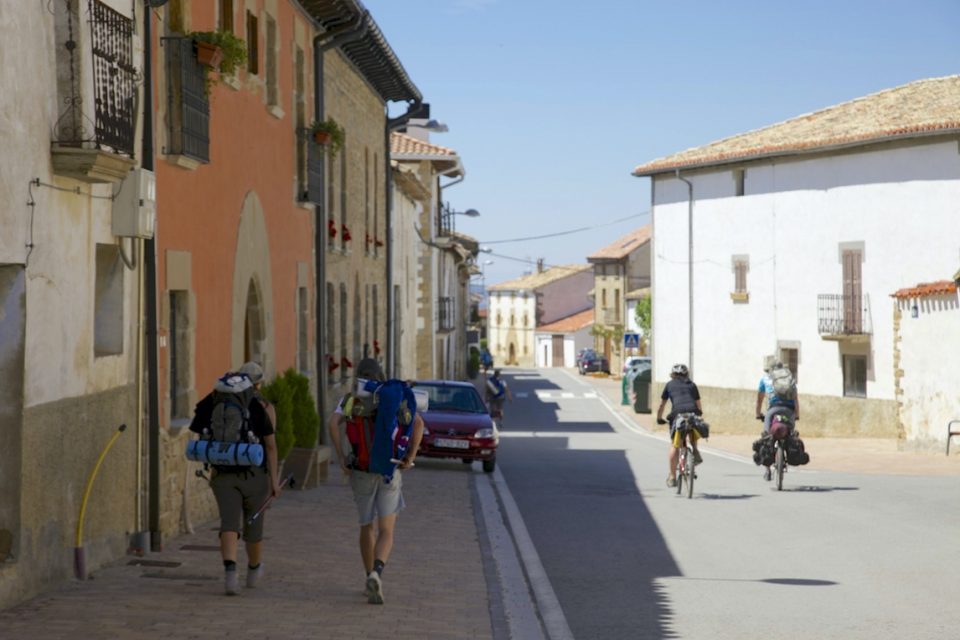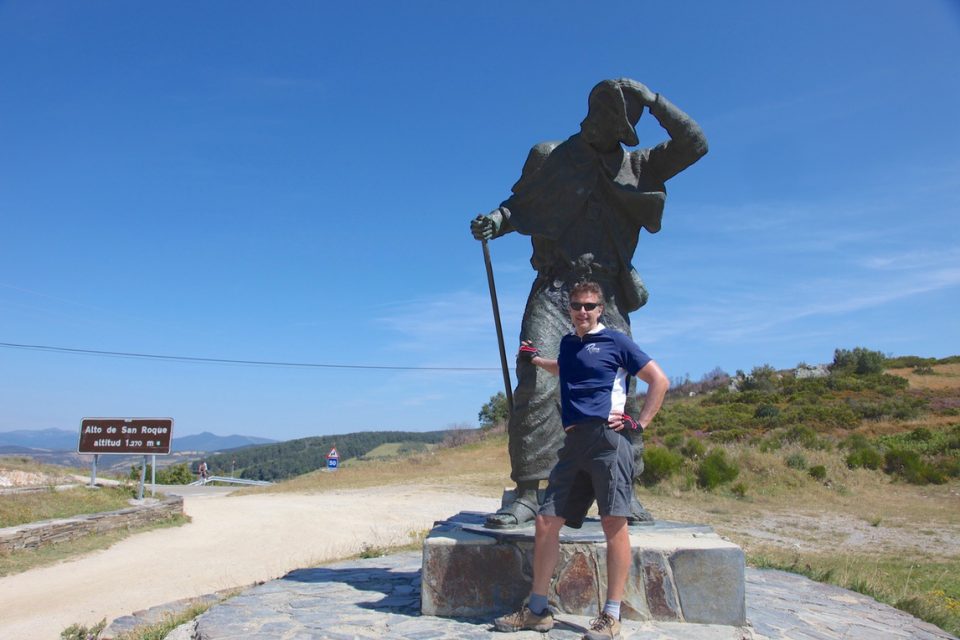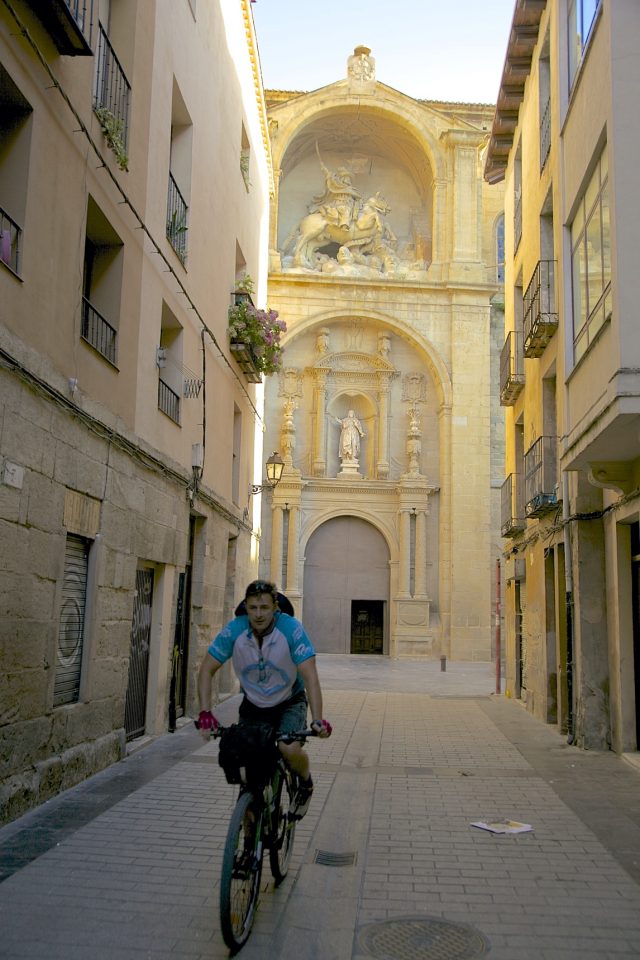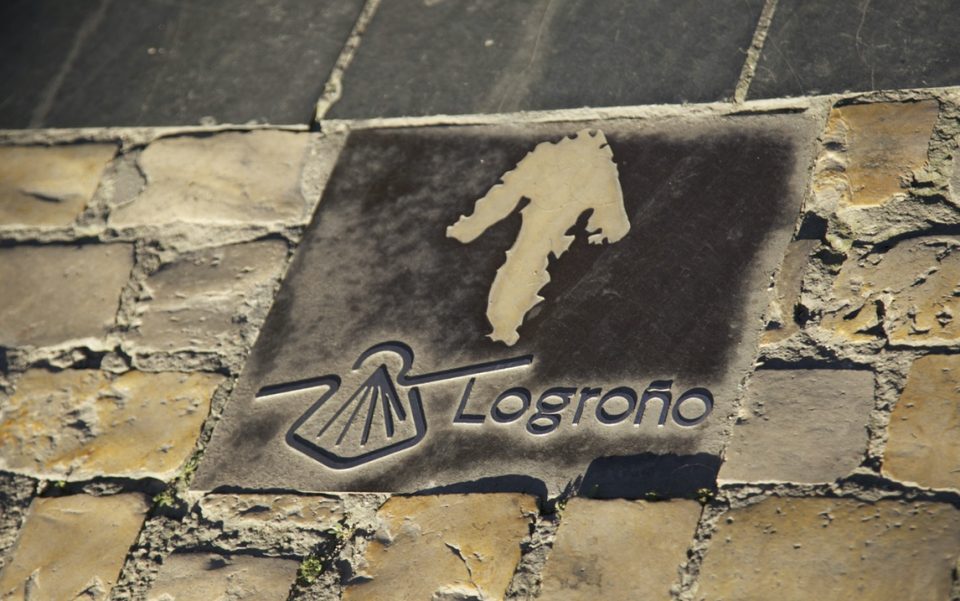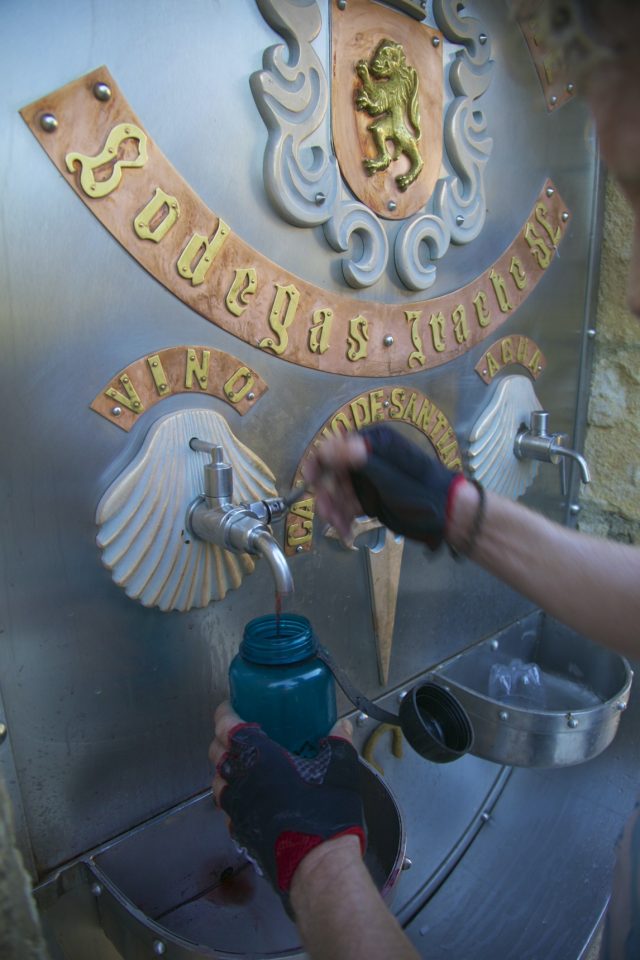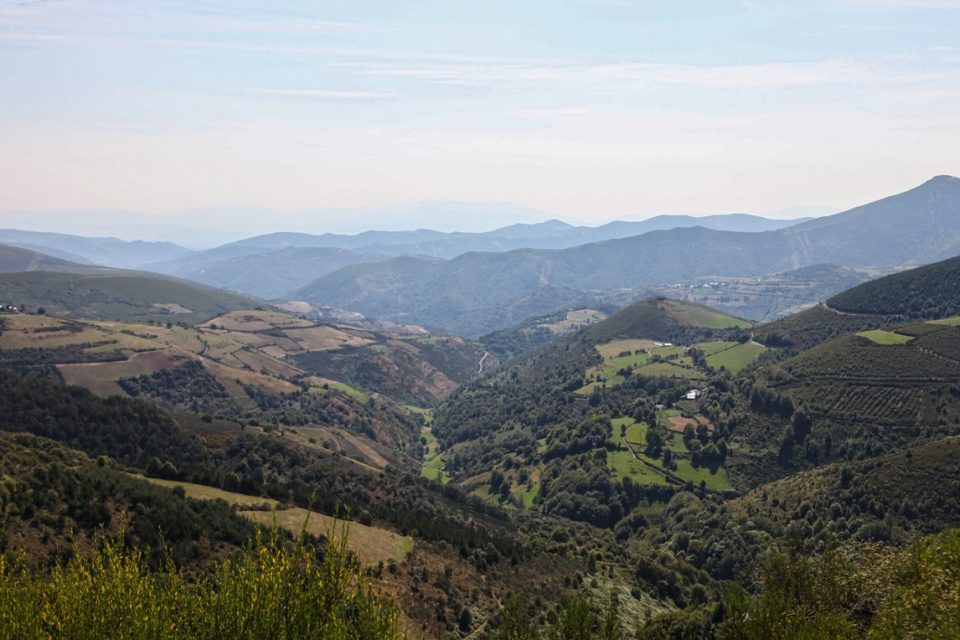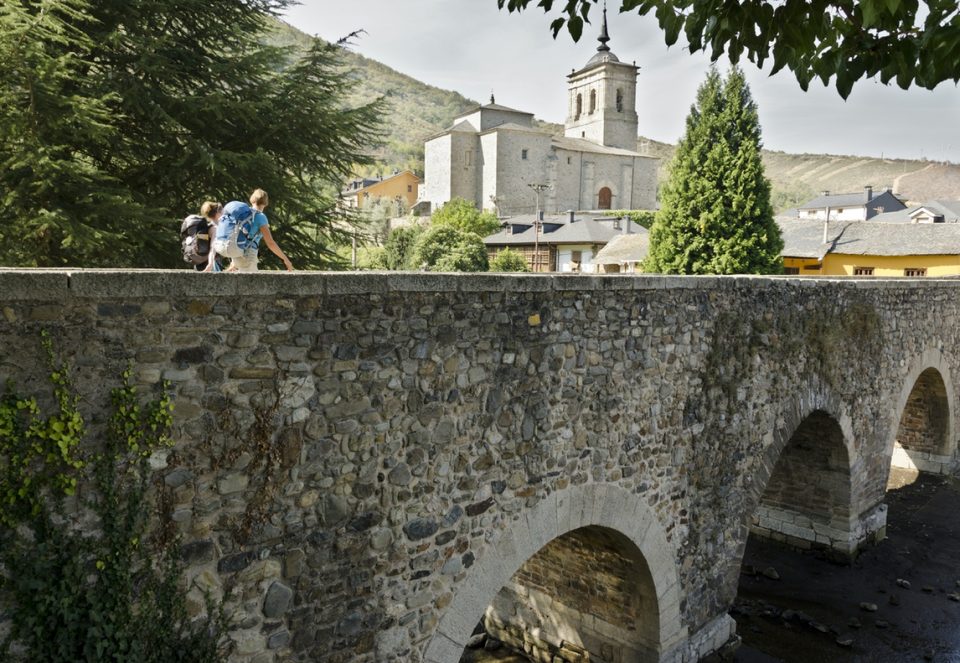length
19 Days
difficulty
Challenging
trip cost
from $4550 pp
Nature Immersion
Cultural Interest
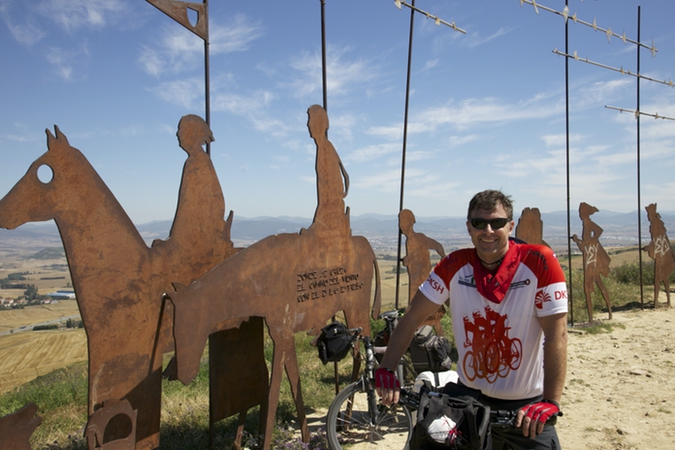
Highlights
Get Ready For
- Mountain bike from Pamplona to Santiago
- Bring a pebble or memento to leave at the Cruz de Ferro
- Indulge the tastebuds; visit the Museo del Chocolate in Astorga
- Finish your pilgrimage walking into the city of Santiago de Compostela

ON THE TRAIL
THE EXPERIENCE
Cycling conditions on the Camino are extremely diverse and range from sealed roads through to non-technical mountain biking over rough terrain with some steep climbs and descents in the more mountainous areas. Some sections are on dirt paths, narrow tracks, rocky trails and offer everything from rolling hills to long flat days, to sustained climbs, short sharp ascents and some slippery descents. Camino walkers share the same path with cyclists and present an added challenge, especially in the busier months. In many cases, alternative routes can be taken along roads rather than the Camino trail, however these require more navigational skill as those alternative routes will likely not be signed, and you will likely encounter traffic.
Itinerary
DAILY DETAILS
Week 1: Pamplona to Burgos
Day 1: Arrive Pamplona
Arrive into the historic city of Pamplona. Your bike will be waiting for you when you arrive at your hotel and you just need to assemble the handlebars and pedals from the box – an easy 10-minute job!
If you have time, get out and immerse yourself in the narrow cobbled streets of Pamplona which burst with colour and life. Explore the many galleries, churches and sights of this vibrant city. Alternatively, head to Cafe Iruna on the main plaza where Hemingway and other celebrities hung out, pay close attention to its art deco interior which has not changed over the decades. That evening, dine in one of the city’s award-winning restaurants specialising in elaborately prepared ‘pinchos’ or finger foods.
Day 2: Cycle Pamplona to Puente la Reina (24km)
From Pamplona you head off on your first ride along the Camino Trail. The first 13km of today’s ride is a fairly steep ascent once you get past Cizur Menor to the peak of Alto del Perdon (the Hill of Forgiveness), as you ascend you can get some amazing views back over Pamplona and onto the south. After your steep ascent you now get to descend for the next 11km taking you into Puente la Reina.
Meals: B
Day 3: Cycle Puente la Reina to Los Arcos (43km)
The morning starts crossing the Queens Bridge whose six arches span the Arga that over time has swollen to become a powerful river. Ride over gently rolling hills made up of farmland and vineyards towards Estella. Estella is a vibrant town with lots to do and see, and may be a good place to stop for lunch as it is filled with varied restaurants and bars.
From Estella you can embark on your last 22kms riding for the day, there is a steep ascent once you pass Azqueta to Villamayor de Monjardin which is at an elevation of 650m. But you will be rewarded with gorgeous views of the surrounding countryside. From here you will be pleased to know it is a gradual descent all the way to Los Arcos where you will be spending the night. Los Arcos is a classical pilgrim halt and has Roman origins. Make sure you take a walk through the narrow streets and breathe in the tranquility.
Meals: B
Day 4: Cycle Los Arcos to Najera (57km)
Prepare for some steep ascents today. Early in the ride pass by Ermita de la Virgen which is precariously perched on the road’s highest point. You will get great views over the flat plains ahead with Viana and Logrono in sight. From the village of Bargota the path descends sharply down into a ravine and you cross the river Cornava (often dry). Once you make your way up to the top of the next hill Viana should be clearly in sight. Viana is a historical town that has changed little since medieval times and the majority of its 15th century architectural heritage is still intact.
From Viana enjoy the downhill riding towards Logrono which is a great halfway point to stop for lunch. Longrono is a vibrant city with a population of approximately 130,000. Logrono is the capital of La Rioja which is a famous wine-growing region. This old town is a fantastic mix of medieval and modern with plenty of bars, restaurants and shops centered around the main pedestrian street.
Hopefully after lunch you have fueled up and are raring to go as there is a challenging ascent of up to 400m over the next 22km. You pass through Alto de la Grajera which will give you views back over the route you have just come and to Longrono, along this section we are told there is no way to happiness – Happiness is the Way! Your legs will get a short break over the next 3km as there is a gradual descent into Navarrete before you continue your ascent up to Alto de San Anton.
Navarette is another town where all efforts have been made to preserve the original period homes and the 16th century Church of Assumption takes a commanding position at the top square. On the main road at the other side of town there is another busy square with a number of cafes and restaurants, you may want to stop here for a celebratory coffee or wine as it is now downhill all the way to Najera, your final destination for the day!
Najera is where you will spend the night and is another good mix of old and new. You will enter this town via the modern eastern quarter with the old town sandwiched between the river Najerila and the towering rock face that acts as a spectacular backdrop with its ancient Castillo.
Meals: B
Day 5: Cycle Najera to Belorado (44km)
Today is a shorter day of riding again, with the first half of the day being along wonderful wide country tracks passing through remote and gently rolling farmland. The first 5km is a fairly leisurely ride which takes you into the town of Azofra. Azofra is a small village with a population that barely hits 500 and relies on the Camino for its survival. From Azofra you pass over the river Rio Tuerto and continue on a pleasant track that winds all the way up to Ciruena. From here you start an enjoyable descent into Santo Domingo de la Calzada.
Santo Domingo de la Calzada owes its inspiration to Saint Dominic of the Road who built a pilgrim hospital, now the Parador and a church which has evolved into the Catherdral, both are located in the historic town square Plaza del Santo. Saint Dominc of the Road dedicated his life to improving the physical route for the pilgrims. This town has a good variety of places to eat and shop along the main busy streets and also in the smaller interconnecting laneways.
The rest of today’s riding towards Belorado is along the newer roads which is quite close to the main N-120 with little shelter and water, so be careful on your bikes along this section and make sure you have filled up your water bottles. You will get a respite from the busy road when you pass through the villages en route.
You will pass through Granon, Redecilla del Camino, Castildelgado, Viloria de Rioja and reaching Villamayor del Rio which might be a nice rest spot before your final 5km into Belorado.
Belorado has a nice down to earth feel about it and is populated by people who work at a leisurely pace. There is a medieval arcade lined with shops, bars and restaurants which is located in the spacious Plaza Mayor. The 16th century Church of Santa Maria has a lovely altarpiece with images of Santiago Matamoros y Pelegrino and is built alongside the limestone cliffs.
Meals: B
Day 6: Cycle Belorado to Burgos (50km)
Varied terrain is today’s mission with a nice change from yesterday riding on busy road to paths and earth tracks. From Belorado you will travel along level open countryside with some shade provided by hedgerow and woodland. Once past Villafrance Montes de Oca you will start the fairly difficult ascent to the highest point for the day at Alto de Valbuena, you will pass through beautiful oak woods and when you reach the peak it is a gradual descent to San Juan de Ortega.
San Juan, a disciple of Santo Domingo, was known for his work to serve the pilgrim to Santiago. He built bridges, hospitals, churches and hostels and even founded an Augustinian monastery, which is dedicated to San Nicolas de Barri who is said to have saved San Juan from drowning on his way back from the Holy Land.
From here the riding isn’t too bad and is mostly downhill all the way to Burgos. From San Juan de Ortega you drop down into the peaceful valley of the Rio Vena and once past Atapuerca you have one final hill to conquer before you descend the rest of the Way.
Once you hit Burgos make sure you make a stop at the Burgos Cathedral. The 13th century Catedral de Santa Maria is one of Spain’s largest and most beautiful, and combines many different styles but is predominantly Gothic. Whatever condition you are in it is worthy of a visit to the interior. You will stay in Burgos for the night and have all of tomorrow to explore, rest and recuperate!
Meals: B
Day 7: Burgos - rest day
Today is yours to explore. Spend the day checking out all that Burgos has to offer including the beauty of many of the city’s buildings. Burgos is sometimes known as the Gothic capital of Spain and has a growing population of around 200,000. The week either side of 29 June is the city’s main festival of San Pedro y Pablo.
Caution is recommended in Burgos with common stories of theft and overcharging so it is best to keep your wits about you.
Meals: B
Week 2: Burgos to O Cebreiro
Day 8: Cycle Burgos to Castrojeriz (41km)
Back on the bikes today we leave the bustling city of Burgos to virtual wilderness. The track on this section is mainly earth and you travel through what seems like never-ending crop fields. This section of the route is often referred to as the Meseta. You may come across a shepherd and his herd but if not it will most likely be just you and the birds. The Meseta also has zero shade from the sun so make sure you are well covered up.
Hornillos del Camino is your half way point for today’s riding and is a classic pilgrim village where little has changed over the centuries. This is a great place to immerse yourself in the ancient atmosphere of the way.
Once past Hornillos del Camino there are few towns en route to Castrojeriz so make sure you are stocked up with any water and supplies you might need. We are again traveling along the lonely Meseta towards Hontanas, a small town of just 80 which is tucked away in a fold in the landscape. This town is largely undiscovered except by pilgrims and has a solid parish church which dominates the tiny village square.
From Hontanas there is less than 10km to go, the last 2km downhilling into Castrojeriz where you will spend the night. Castrojeriz is the perfect place to rest for the night as it is a small sleepy town of just 600 with an obsession with siesta. If you still have a little energy left it is well worth the walk up to the hilltop castle Castillo as you will get lovely views over the town and countryside. If not just take a load off and relax in one of the local bars with a beer.
Meals: B
Day 9: Cycle Castrojeriz to Carrion de los Condes (44km)
Today you start with a steep climb out of Castrojeriz to get back onto the Meseta, but never fear there is a downhill slope on the other side. Again today’s riding will see you in little shade on earth tracks with few water stops so make sure you take precautions. About 7km into your ride you will come across a small village called Itero de la Vega with a population of only 190. After Itero de la Vega you will pass over the Canal Pisuerga with a gentle incline before descending into Boadilla del Camino.
Boadilla del Camino originally had a population of over 2,000 which once served the multiple pilgrim hospitals, but the population is now only a mere 200. Continuing on a few more kilometres you will reach Fromista. Fromista is best known for the beautiful 11th century Iglesia de San Martin which was built with a gorgeous mellow stone. With over 300 external corbels each carved with a different human, animal or mystical motif this is a must see site.
From here we are off the earth tracks and onto what is often referred to as the pilgrim autopistas which run alongside the main roads. Around 13km from Fromista you will enter the town of Villalcazar de Sirga which is well known for its hospitality. Now declared a national monument, the town of Villacazar de Sirga is home to the superb 13th century Templar church of Santa Maria la Virgen Blanca. This church houses the tombs of royalty and nobles alike.
Only a short 5 more kilometres to your resting place for the night – Carrion de los Condes. This fascinating town retains its medieval atmosphere in its quiet side streets and was home to no less than 14 pilgrim hospitals. The town has a variety of shops, bars and restaurants so take your pick!
Meals: B
Day 10: Cycle Carrion de los Condes to Mansilla de las Mulas (77km)
Today’s ride is a long one but it is generally flat all the way. Make sure your bellies are full and your water bottles are filled as there are no facilities for the first 17km until you reach Calzadilla de la Cueza. If you need to stock up on snacks you can do so here or wait until you make it to Ledigos which is only another 6km down the track. From Ledigos it is a short ride to Terradillos de los Templarios a small humble village of just 80 residents.
The next major town we hit is Sahagun, which is full of ancient monuments. Sahagun was the seat of great religious power, largely because of the influence of Alfonso VI who, along with his numerous wives, is buried in the Benedictine convento de Santa Cruz. From Sahagun you will make your way to Bercianos del Real Camino where you may want to stop for lunch or a break as there are not many townships over the final kilometres to your overnight stop of Mansilla de las Mulas.
Meals: B
Day 11: Cycle Mansilla de las Mulas to Leon (18km)
Arrive into the lively city of Leon, capital of Castile and Leon. Spend the day exploring this beautiful city and its incredible Gothic cathedral, which is renowned for its marvellous stained glass windows. The streets of Leon come alive in the evenings when people parade the streets and its bodegas are overflowing with people.
Meals: B
Day 12: Cycle Leon to Astorga (53km)
There are two routes available for this morning, both start at ‘La Virgen Del Camino’ and converge at ‘Hospital de Orbigo’ – one is a more indirect route that goes via Villar de Mazarife and has better scenery and less traffic, a more pleasant ride. The other route runs parallel to the autopista (highway) is less peaceful but quicker. You will see pilgrims on both routes but we’d recommend the quieter one via Villar de Mazarife. Stop for refreshments at the cafe overlooking the extraordinary bridge the ‘Puente de Orbigo’ – built on a Roman bridge this one dates from the 13th century and is one of the best preserved bridges in Spain.
You then ride the final 15km to reach the beautiful walled town of Astorga, with views of the mountains of Leon in the distance. On this last section you will cross over a few kilometres of quite rough tracks over rolling terrain before you reach the cross which overlooks Astorga. Look out for the small basic ‘Cantina’ at the top of the hill, a welcome refreshment stop before you reach the cross. Continue on to Astorga, which offers a number of attractions including a Cathedral by Gaudi and a delicious chocolate museum!
Meals: B
Day 13: Cycle Astorga to Molinaseca (46km)
Leaving behind Astorga you cycle on pleasant paths across the plains with good views of the hills before you. Look out for the Cowboy Bar at El Ganso, a good place to stop for morning coffee. After El Ganso you start to climb to Rabinal del Camino and you’ll start to feel the incline which will steepen as you get further into the hills towards Foncebaddon – the infamous deserted village which is no longer deserted! The incline is always rideable however and there are plenty of switchbacks with great views back over the plains from where you’ve come. At the top of the hill is the Iron Cross, where pilgrims leave something whether a pebble they’ve carried or a bad habit or memorial to a loved one.
Meals: B
Day 14: Cycle Molinaseca to O Cebreiro (61km)
Today is a big day of hills, the Camino climbs into the city of Ponferrada past the castle of the Knights Templar, worth a quick coffee in the plaza to admire the hills you’ve just climbed over the day before. After Ponferrada continue on through gentle rolling hills and vineyards to reach the charming town of Villafranca del Bierzo, nestled in the hills that mark the border with Galicia. From here continue onwards and upwards to overnight at O Cebreiro which lies at the top of the mountains, a further 30km and 800m vertical ascent.
Meals: B
Week 3: O Cebreiro to Santiago
Day 15: Cycle O Cebreiro to Samos (40km)
From O Cebreiro you have one or two more uphill stretches to conquer before an amazing long freewheeling descent of almost 20km to reach Triacastela. After Triacastela you continue along the river valley to Samos, home to an impressive monastery which dominates this little town. The monastery is now a museum and well worth a look. From here you will continue along the road to Sarria.
Meals: B
Day 16: Cycle Samos to Palas De Rei (58km)
Today you’ll continue through the beautiful green Galician countryside to the modern town of Sarria, which is a major stop on the pilgrim trail – walking pilgrims can start here to cover the last 100km and earn their Compostela. Immediately after Sarria you will cross a series of low hills of up to 600m which will eventually lead you down to Portomarin, the route is along tree lined paths and country roads so very pleasant riding. After Portomarin the Camino climbs again for 400m of ascent before finally rolling down the last 20km to Palas De Rei, a modern town.
Meals: B
Day 17: Cycle Palas De Rei to Santiago (70km)
Your final day on the bike as you approach the holy city of Santiago. Today’s ride is a fitting end to the Camino, as you pedal along rural roads through woodlands and pastures to Santiago, meandering along forgotten country roads through the beautiful Galician countryside. Rolling hills and green pastures predominate as you approach the final stretch to Santiago and feel the excitement building as you glimpse the towers of the Cathedral.
Meals: B
DAY 18: Santiago at leisure
This morning you will need to take your bikes on a short ride back to the bike shop to drop-off, and you will then have the whole day to enjoy and explore historic Santiago with its many enticing tapas bars and restaurants. You can attend the midday pilgrims mass and look around the famous Cathedral of St James which forms the city’s heart and watch the steady stream of pilgrims arriving into the square as they finish their epic journey.
Meals: B
Day 19: Depart Santiago
You are free to check out of your hotel any time before 10am. If you would like to explore Santiago further you are able to leave your bags with reception.
Meals: B
Carbon footprint & our regenerative actions
17kg of CO2-e per person per day
We pay for a monthly offset to cover the estimated emissions of our walkers for all trips with RAW Travel, which goes into local reforestation or biodiversity restoration. Explore the practical actions behind these estimated carbon offsets for your trip here, following a philosophy of ‘re-wilding the planet’ with native tree planting & Ocean plastic cleans ups.
A reasonable estimate for a pilgrim is 17 kg of CO2-e per person per day, primarily due to hotels, meals and emissions from luggage transfers. The act of walking itself is a form of sustainable travel, so the carbon footprint calculated here is a measure of the ancillary activities surrounding the walk, not the walking itself. The figures are estimates, not precise measurements for each route/trip, as it’s difficult to provide an exact number without detailed data on specific hotels, menus, and transfer routes which vary from person to person. This figure represents the operational footprint of the hike and its included services only. It does not include the flights and other transport needed to get to the start and finish of the walk.
An individual can significantly influence their footprint with the varied choices they make around food and drink at each meal. For instance, a diet rich in meat, imported goods and alcohol, will have a much higher impact than one focused on local, seasonal, and plant-based options. This daily stated figure is an average across the 18 days of the pilgrimage, derived from the key consumption components listed below.
Carbon Footprint Breakdown
|
Component |
Daily Estimate (kg CO2 e per person) |
Notes on Itinerary Impact |
|
Accommodation |
8 kg |
Accounts for 18 nights in private rooms within hotels and more modest guesthouses/B&Bs in rural areas. |
|
Food (B + Self-Paid L/D) |
7 kg |
The itinerary includes a daily breakfast; lunch and dinner are self-paid. |
|
Shared Transfers & Local Transport |
2 kg |
Covers your share of the daily, efficient shared luggage transfers between all stops and e-bike charging. |
|
Overhead & Miscellaneous |
N/a |
This is calculated & accounted for separately and includes emissions from waste, administrative operations, and general energy/water usage for our offices |
|
Total Estimated Daily Footprint |
17 kg |
(Sum of the above) |
Map
Pamplona to Santiago: Mountain Bike map
Pamplona
While the small city of Pamplona is world-renowned for its Fiesta de San Fermín held every July, there is so much more to this atmospheric city than wild bulls stampeding down the main street. This vibrant Spanish city is bursting with artistic, historical and gastronomical highlights! You can spend hours happily getting lost while discovering some of the main sites and hidden gems. We recommend dining in the city’s award-winning restaurants that specialise in elaborately prepared ‘pinchos’ (finger foods) and doing a foodie tour.
CLICK ON A PIN TO REVEAL INFORMATION ABOUT THAT LOCATION
Puenta de la Reina
The small town of Puenta de la Reina (translated as ‘Bridge of the Queen) is famous for its perfectly balanced 11th century stone bridge; it’s one of the most famous photos of the Camino. It is the point where the Camino Francés meets the Aragonese Route. As a result of the two paths crossing, Puente la Reina has been a major meeting point along the Camino for hundreds of years.
Estella
Estella is a lovely small town split in two by the Ega River and surrounded by conic, wooded hills topped with castles (or their ruins) and churches attesting to its long history as a crucial centre of commerce. Just outside of Estella you will find the famous Irache fountain that dispenses free red wine to thirsty pilgrims (courtesy of the Bodegas)!
Los Arcos
Los Arcos is another charming village situated along the Camino. It is a classical pilgrim halt that is known for its old town, with cobbled streets and well-preserved buildings. The village offers a range of services for pilgrims, including restaurants, grocery stores, pharmacies and medical facilities.
Logroño
The capital of the La Rioja region is home to some of Spain’s most celebrated red wines. It has one of the most distinguished culinary traditions in Spain. There are over 50 taperías (tapas restaurants) located within a four-block area close to the town centre. The traditional tapas restaurants often serve only one tapa (such as mushroom), served as pincho (pintxo in Basque), meaning one serving. Many pilgrims also elect to include a rest day here.
Nájera
Historically important, Nájera was used by Navarran kings during medieval times after King Garcia Sanchez chose it as his base. The town is built on the banks of the river Najerilla and along its banks, you will find the Monasterio and Iglesia de Santa María La Real built in 1032. You enter this town via the modern eastern quarter and the old town sandwiched between the river Najerila and the towering rock face that acts as a spectacular backdrop with its ancient Castillo.
Santo Domingo de la Calzada
This town owes its inspiration to Saint Dominic of the Road who dedicated his life to improving the physical route for the pilgrims and built a pilgrim’s hospital (now the Parador) and a church which has now evolved into the Cathedral. Both buildings are located in the historic town square Plaza del Santo where you will find a good variety of places to eat and shop.
San Juan de Ortega
This small village in the province of Burgos is home to the Monastery of San Juan de Ortega, a Romanesque architectural gem. Setamidst beautiful forests and fields, it is peaceful and tranquil.
Burgos
Burgos is sometimes known as the Gothic capital of Spain. The Burgos Cathedral is one of the most iconic landmarks in the city. This UNESCO World Heritage Site is often considered one of the most beautiful cathedrals in Spain. The city’s dining scene offers a taste of Castilian gastronomy. Pilgrims often have a rest day here.
Hornillos del Camino
In this classic pilgrim village, little has changed over the centuries. It is a great place to immerse yourself in the ancient atmosphere of ‘the way’. Once you leave Hornillos del Camino you are again travelling along the Meseta. There are few towns en route to Castrojeriz, so make sure you are well stocked with any water and supplies you may need.
Castrojeriz
Castrojeriz is the perfect place to rest for the night as it is a small sleepy town with an obsession for siestas. If you still have enough energy it is well worth the walk to the hilltop castle Castillo where you enjoy lovely views over the town and countryside. If not, relax with a beer in one of the local bars.
Frómista
Frómista is best known for the beautiful 11th century Iglesia de San Martin which was built with gorgeous mellow stone. With over 300 external corbels each carved with a different human, animal or mythical motif, this is a must-see site.
Carrión de los Condes
This fascinating town retains its medieval atmosphere with its quiet side streets. At one time it was home to no less than 14 pilgrim hospitals! The town has a variety of shops, bars and restaurants.
Terradillos de los Templarios
This small humble village of just 80 residents is the approximate halfway point of the full length Camino.
Calzadilla de los Hermanillos
This small village in the province of León is set amidst the beautiful Castilian landscapes, characterised by open plains, farmland, and the distant peaks of the Cantabrian Mountains. The scenery adds to the tranquil and rural ambiance of the place.
Mansilla de las Mulas
As you head towards the walled town of Mansilla de las Mulas the landscape becomes a little hillier with wine storage cellars and bodegas set into the hills. The town’s name is derived from the Latin ‘mansio’, which means ‘stopping place’. Notable landmarks include the Puerta del Sol, a medieval gate that was part of the town’s defensive walls, and the Church of Santa María, which is a beautiful example of Gothic architecture.
León
León is a beautiful city with an incredible Gothic cathedral, renowned for its marvellous stained-glass windows. In the evening the narrow streets and plazas come alive when locals flood the local bodegas, cafes and restaurants. León is surrounded by picturesque natural landscapes, such as the Picos de Europa mountain range and the green, hilly countryside of Castile and León. Pilgrims often have a rest day here.
Hospital de Órbigo
The small town of Hospital de Órbigo is famous for its remarkable medieval bridge, the Puente de Órbigo. This bridge, also known as the “Passo Honroso” (the Passage of Honor), was the site of a medieval jousting tournament where knights vied for the affection of a lady. The bridge and its history are significant for pilgrims on the Camino.
Astorga
Astorga has a rich history dating back to Roman times and remnants of Roman walls and mosaics can still be seen in the town. The cathedral is a Gothic and Renaissance masterpiece and a must-visit. Astorga is also famous for the Episcopal Palace designed by the renowned architect Antoni Gaudí. This modernist building is a distinctive architectural gem and now houses the Gaudí Museum.
Rabanal del Camino
This village has a long history related to the Camino de Santiago. It was historically known for its hospitality to pilgrims and many pilgrims find it to be a spiritually significant place.
Molinaseca
This picturesque village offers a charming atmosphere with its cobbled streets and a medieval bridge over the Meruelo River.
Villafranca del Bierzo
This charming town is nestled in the hills that mark the border into Galicia. Both Molinaseca or Villafranca del Bierzo are great places to consider an additional rest day.
O’Cebreiro
The atmospheric hilltop hamlet of O’Cebreiro feels vaguely Irish. It’s known for its straw roof houses (pallozas) and is located on the Galicia border, about 150km from Santiago.
Triacastela
Triacastela is a charming village located in the province of Lugo. It is surrounded by beautiful Galician landscapes, including rolling green hills, lush forests, and serene rivers.
Sarria
Sarria is a busy, modern town with plenty of shops, hotels, restaurants and bars. It is bustling with pilgrims – those who began their Camino hundreds of kilometres back as well as the large number that walk the final 100km to Santiago de Compostela to qualify for their Compostela.
Portomarin
Portomarin has been inhabited for thousands of years and its importance grew with the popularity of the Camino in the middle ages. At one time it had three orders of Knights: the Knights Templar, the Knights of St John and the Knights of Jerusalem, which may go some way to explaining the castle-like edifice of the 12th century Romanesque Igelsia San Nicolas church which still stands in the square at the centre of town.
Palas de Rei
This town was a favourite place of residence of the Galician nobility and the importance of the Jacobean pilgrimage in this village goes back to time immemorial.
Arzúa
This is the last large town before you reach Santiago. It has plenty of restaurants bars and cafes and a few ATMs. The 14th century Capilla de la Magdelena is the town’s main monument. Arzúa is most famous for its local cheese, Queixo, a smooth creamy cheese made from cow’s milk which most restaurants feature in some way and is definitely worth trying.
O Pedrouzo
This small busy town has plenty of shops, restaurants and bars. It is the last stage of the Camino before entering Santiago de Compostela.
Santiago de Compostela
The wonderful and historic city of Santiago is the end of the Camino journey for most pilgrims. Praza do Obradoiro and the wonderful ancient Cathedral form the city’s heart. Attend the midday pilgrims mass and watch the steady stream of pilgrims arriving into the square as they finish their epic journey. There are many enticing tapas bars and restaurants in which to celebrate your journey.
Inclusions
What's included?
Included
- Specialized Carve Comp 29 mountain bike (15”-21” frame sizes)
- Ortlieb rear panniers
- Toolkit, lock, and pump
- Cycling helmet upon request
- Drop off and collection of bike
- 18 nights excellent accommodation including historic hotels and character country houses.
- Private en-suite rooms on a twin share basis
- Daily breakfast
- Luggage transfer each day from hotel to hotel (1 x 20kg bag per person)
- RAW Travel navigation APP with maps of your hotel locations and emergency contact numbers
- Local emergency contact numbers
- Pre-trip Camino guidance and planning
- Dedicated local support person in Spain for reassurance
Excluded
- Single supplement $1260
- Lunches and Dinners
- Travel insurance
- Flights
Added Extras
With our Individual Trips, guests have the freedom to choose their own departure date and tailor their itinerary to suit their cycling preferences, subject to availability along the trail. Request an itinerary from our destination experts, and they’ll provide notes on days where distances can be adjusted, suggestions for adding rest days, and options for additional luggage transfers or upgraded accommodation.
For an extra indulgence, upgrade your hotel in Santiago to a Parador from $180 per person/per night twin share and $275 per person/per night single occupancy, when booked 6 months in advance (subject to availability).
For any part of your trip that falls between 31 October and 31 March there is an ‘out of season’ luggage transfer surcharge cost of $30 per person per day.

What's my ride?
The Bike
For cycling the Camino, we provide Cannondale Trail SL 2 or similar hardtail mountain bikes. These modern bikes feature a lightweight aluminium frame, RockShox forks, and Shimano components, including a Monoplate with Shimano Deore 12-speed SLX gears. The pedals are dual-platform—one side functions as a regular pedal, while the other is compatible with Shimano cycling shoes. For clients cycling only in Galicia, different mountain bikes are supplied—typically Felt Dispatch 9/60 hardtail mountain bikes or a comparable model.
Please note that bike models may vary depending on availability on your chosen date, but all will be of a similar quality and standard.
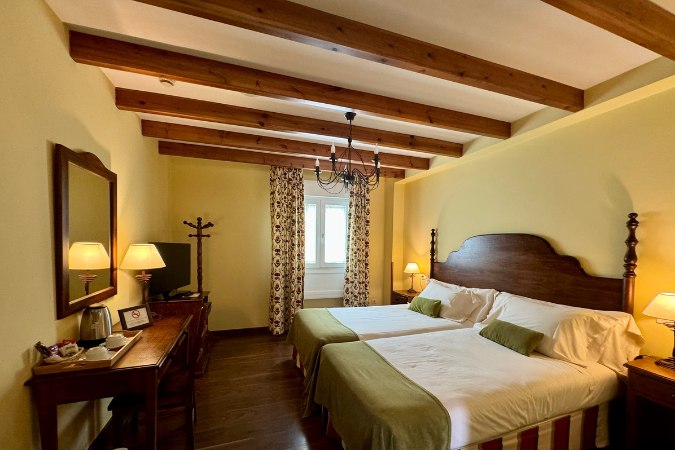
ACCOMMODATION
WHERE YOU STAY
Accommodation on the Camino de Santiago offers a diverse experience, from well-located approx. 3 to 3+ star hotels in cities and larger towns, to comfortable boutique stays and restored historical properties. In smaller villages and hamlets, we often use Casa Rurales – traditional rural homes that have been lovingly transformed into welcoming B&B-style stays, often run by local families. These provide a wonderfully authentic experience, full of character and warm Spanish hospitality. As the Camino passes through rural areas, not all accommodation is directly on the trail. If this is the case and if it is not possible to cycle to your stay, your hosts will arrange pick-up and drop-off transfers, so you can enjoy a seamless experience.

GASTRONOMY
FOOD & WINE
The Camino Francés offers a broad and accessible introduction to Spanish cuisine, with plenty of opportunities to enjoy regional dishes along the way. From Galicia’s famous pulpo a la gallega (octopus with paprika and olive oil) to the hearty stews and cured meats of Castilla y León, food plays a steady – if simple – role in the pilgrim experience. Most towns and villages offer pilgrim menus at local bars, restaurants, and albergues, providing good-value, no-fuss meals. While dining is generally more available than on more remote routes, it’s still a good idea to keep snacks on hand between smaller towns. Expect comforting, traditional fare that reflects the changing landscapes and cultures of northern Spain. Read more about food along the Camino in our insight article, “Lunch on the Camino“
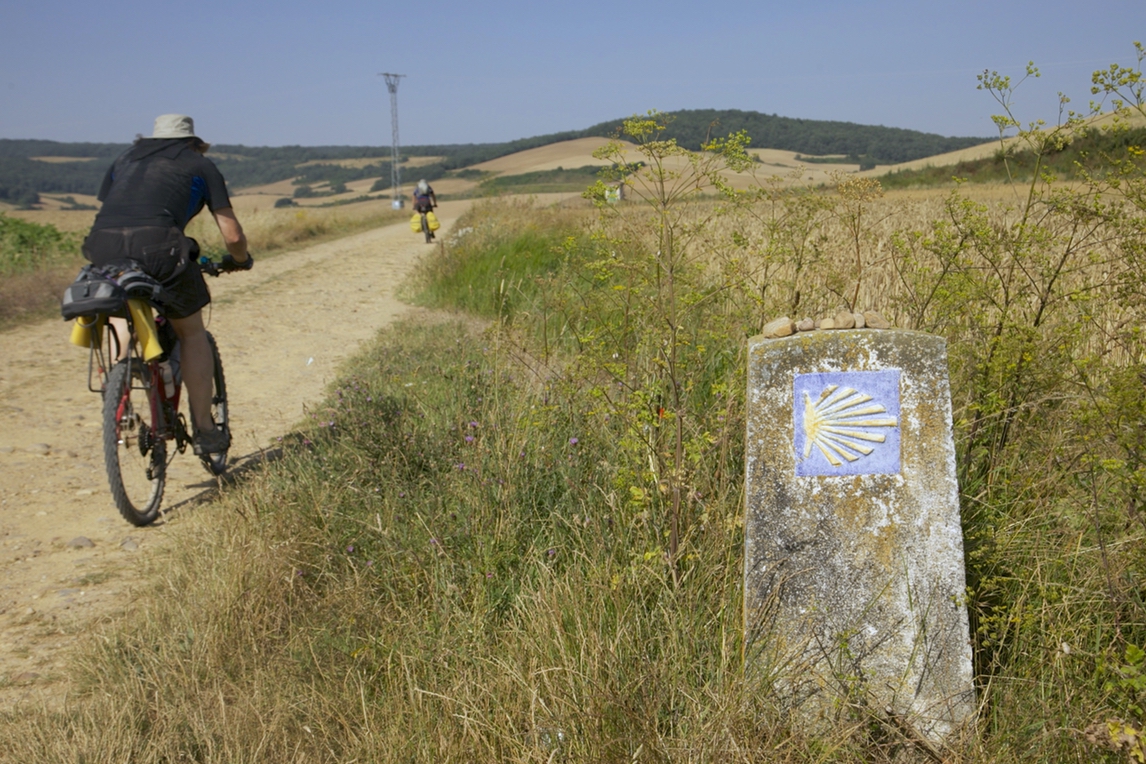
CAMARADERIE
Shared pilgrim path
The Camino Francés welcomes over 200,000 pilgrims each year and remains the most popular route. For cyclists, daily distances are typically longer than those of walkers, often allowing less time for socialising along the way. While the final 115km from Sarria to Santiago is especially popular with first-timers and those seeking connection, cycling the Camino tends to be a more solitary experience due to the faster pace and occasional route variations from the walking path. That said, there are still plenty of opportunities to meet fellow pilgrims in towns and rest stops. Traveling in spring or autumn offers a more balanced, quieter experience than the peak summer months. You can learn more in our Insight article, Cycling the Camino.
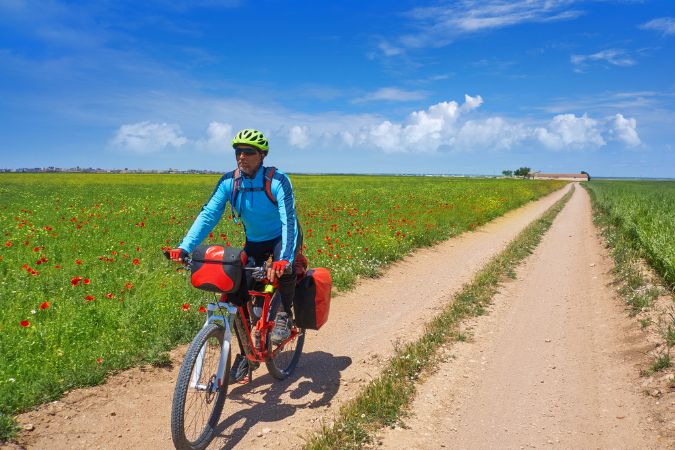
Local Support
Cycle with Confidence
While our destination experts assist you in planning your trip, you can feel confident knowing that once you’re on the ground, dedicated RAW Travel staff based in Spain will be available to support you in real-time throughout your Camino journey—whether it’s an emergency or any situation requiring assistance. Their contact details will be included in your pre-departure information. Although our self-guided trips usually run smoothly, it’s reassuring to know that help is close at hand if needed. For biking trips, you’ll also have direct contact with our trusted local bike operator, who can assist with any bike-related issues along the way. Read more about our incredible on-ground support team: Germán & Daniel.

TRIP INFO & NAVIGATION
RAW TRAVEL APP
Our app gives you access to your itinerary, accommodation details, emergency contacts, and weather information in one handy place. The ‘Route Maps’ feature helps with navigation when trail markings or road signage are unclear or missing. You can also use it to locate your accommodation and key points of interest along your route. While the app is a helpful tool, you’ll still need to be self-reliant with navigation. As with any phone app, it’s not intended to be used constantly while cycling. For the best experience, we recommend following road and trail signs and using a paper map or guidebook as a backup, along with our app. Be sure to download and explore the RAW Travel app before your trip—it’s packed with helpful features to support your journey. Find out more here.
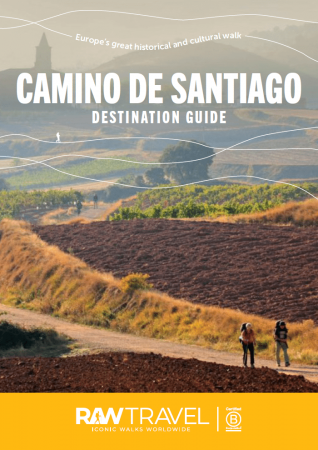
Exclusive Guide
Camino de Santiago
Discover inspiration, travel essentials, practical information and more in our free Destination Guide. All you need to know about walking the Camino de Santiago routes through Spain, Portugal and France!
Walking the Camino is an incredible journey that will immerse you not only in Europe’s grand history, food and culture but most importantly the extraordinary camaraderie that exists along these routes. The spirit of the Camino de Santiago is alive and well among people from all over the world. It is a ‘bucket list’ experience you will never forget!
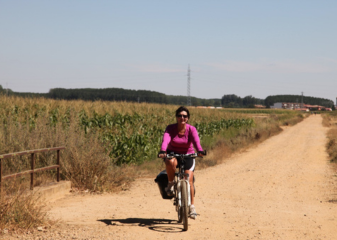
Camino de Santiago
The Camino Stage 3-5. Leon to Santiago: Mountain Bike
- Explore the beautiful city of Leon and its incredible Gothic cathedral
- Visit to the Museo del Chocolate in Astorga
- Bring a pebble or memento to leave at the Cruz de Ferro
- Finish your pilgrimage in the incredible city of Santiago de Compostela
$2,590.00

Portuguese Coastal Camino
Porto to Santiago: Mountain Bike
-
- Cycle from Porto to Santiago on this quieter Camino route
- Enjoy memorable encounters with friendly locals along the way
- Discover historic towns with a wealth of architectural sites and surprises
- Rest or explore with free days in Porto and Santiago de Compostela
$4,050.00
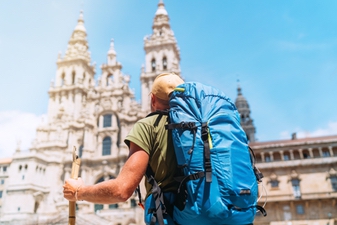
Camino de Santiago
The Full Camino: Walk and Cycle
- Enjoy a sip of wine at the famous wine fountain of Irache!
- Bring a rock from home to leave at the Cruz de Ferro
- Indulge the tastebuds, visit the Museo del Chocolate in Astorga
- Finish your pilgrimage walk into the city of Santiago de Compostela
$7,795.00
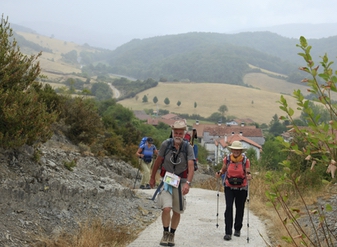
Camino de Santiago
The Full Camino
- Self-guided walking trip; set your own pace
- Enjoy Spain’s rich legacy of history, culture, food and art
- Ideal for single travellers who like the details of their trip well planned
- Country roads, forest tracks over old villages, cities born from the Camino trail
$7,650.00
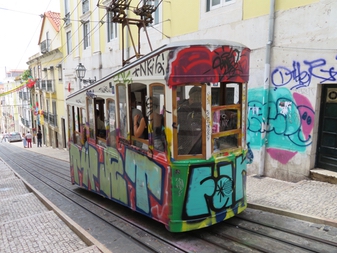
Portuguese Coastal Camino
Lisbon to Santiago – Portuguese Coastal Camino
- Explore Lisbon’s abundant history, fine cuisine and lively culture
- Fresh cod and grilled sardines the world famous ‘Pastéis de Nata’
- Lush fields, olive and citrus groves, beautiful beaches and wild coastlines
- Roman remains, old Knights Templar towns, Moorish bastions
$7,595.00

Camino de Santiago
The Highlights Trip – Camino
- Walk the best sections of the Camino
- Use trains to visit other cities along the route
- Follow in the footsteps of millions of pilgrims
- Dedicated local support person in Spain
$3,095.00
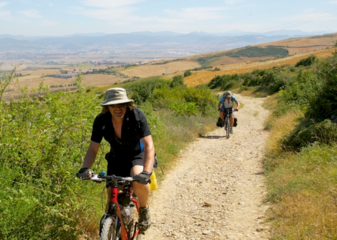
Camino de Santiago
The Camino Stage 2-5. Pamplona to Santiago: Mountain Bike
- Mountain Bike Pamplona to Santiago
- Bring a pebble or memento from home to leave at the Cruz de Ferro
- Indulge the tastebuds; visit the Museo del Chocolate in Astorga
- Finish your pilgrimage walking into the city of Santiago de Compostela
$4,550.00
TRIP date selection
when would you like to travel?
Please select your preferred dates for on-demand trips or select a scheduled date for group departures. If you have booked a self-guided trip please understand that because your trip date is on demand and we must check availability of all properties on your chosen dates before it can be fully confirmed

